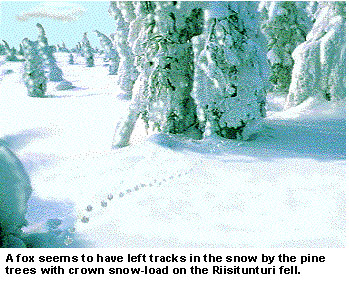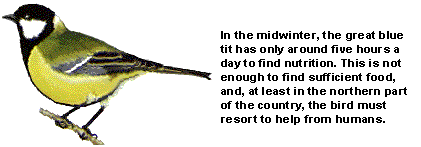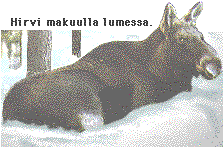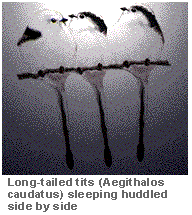THE WINTER OF OUR NORTHERN NATURE

Sorry but some parts and links are not yet translated!
THE WINTER OF OUR NORTHERN NATURE

Sorry but some parts and links are not yet translated!
|
Animals (part 1)
|
|
|
|
|
The link to the hard winter of plants above.
Other topics on our northern nature are found from the picture above.
For other topics on our northern nature nature, go to Main menu!
In this part: 'Hard midwinter/animals', part 1.
See also Means of overwintering of animals and
preparing for winter!
...and also:

Hard midwinter/animals:
part 1:
• Animals either wade in the snow or float on it...
• Winter's day is short to diurnal animals, long to nocturnal ones...
• Winter's night is long and freezing, animals shiver from cold...
part 2:
• Lots of energy is consumed in a cold winter night...
• Our midwinter birdlife - only a part of it survives...
• Small mammals live in the protection of snow during winter...
• The winter life of invertebrates...
WINTER NUTRITION:
part 3:
• Winter nutrition cannot compete with what summer has to offer...
• In the winter, competion over nutrition is harder than in the summer...
• Seeds are full of nutrition - if one can find them...
• Even branches, buds and bark from trees and bushes will do...
• It is not always easy to dig food from under the snow...
Animals either wade in snow or float on it...
Mammals that move in the snow are either floaters or waders. Snow carries floaters, whilst waders sink into it so deep it reaches their stomachs. See: classification of animals! in relation to snow. See also: surface pressure!
Floaters include animals such as the shrew, the weasel and small moles. The hare, the fox and the lynx also stay on the surface of the snow as long as the hardness of its top layer is at least 40-50 g/cm2. Large animals such as the elk have to wade in snow. If the snow cover reaches the elk's stomach, the animal seeks its way to areas with less snow. (Otherwise it can only move on a very small area.)
In the soft snow, many animals have to walk in their own tracks or even in those of other species. The hare and the fox, for instance, create pathways this way. Elks and reindeer also often proceed one after another in the snow. See: animals' tracks in snow!
-----
Disadvantages of snow:
- Nutrition is hidden under snow (gallinaceous birds, the brown hare)
- Moving from one place to another becomes difficult (the wolf, the roe deer)
- Without camouflage an easy catch for predators (the brown hare, the partridge, the black grouse)
Advantages of snow:
- Provides shelter from the cold (small mammals, birds which spend their night in the snow)
- Easiness to move on crusted snow (the fox, the deer)
- Provides a hiding place (birds' caves in snow, small mammals' tunnels in snow)
- The possibility to reach higher branches of trees for nutrition (the reindeer, the hare, the willow grouse, moles)

In midwinter, diurnal birds have only a few hours to find nutrition whilst birds that are active in the twilight hours can spend more time on looking for food. Indeed, many small birds use all of the daylight hours looking for nutrition. The great tit and the jackdaw, for instance, even do this during twilight hours. In Northern Finland, in January, tits are only active a mere five hours each day while in the south of Finland they are on the move for seven or eight hours. See: length of the day!

Large mammals rest in snow pits, which are formed when the animal lies down. The resting place is often merely a spot near the area where they eat; it is not chosen according to any specific criteria.

Even the hare can survive in an open snow pit but any smaller ground mammals must rest in a warm place, in other words, either under the snow or in a hollow or a nest of a tree. When the squirrel is in its nest, the temperature there stays between ten and twenty degrees centigrade despite low temperatures outside.
The crows and birds of prey, among others –excluding the smallest owls– overnight on tree branches. Out of the hibernating small birds, the yellowhammer, the waxwing the pine grosbeak and crossbills do this as well. In freezing temperatures some small birds (tits, the bullfinch, the goldcrest) might even seek cover from hollows in the snow or from snow tunnels made by small mammals.
All woodpeckers including the black woodpecker, as well as most tits, seek their way to nesting boxes and hollows of trees for the night. Temperatures in the tree hollows are not much higher than in the outside air, but the hollows do provide shelter from the wind. In the Southern Finland, the pine marten can tolerate the low temperatures of winter nights in hollows of trees, nesting boxes or squirrel nests, whilst in the Northern Finland it often seeks its way under the snow to, for example, boulder fields for the night.

Some birds such as tits, the sparrow and the jackdaw find relatively warm places near settlements, in which to spend the night. Compared to general nighttime temperatures, air is warmer, for instance, under street lamps' globes or by ventilation channels of residential buildings. Air also tends to be a few degrees warmer in densely populated areas, i.e. in towns, than on the countryside. That is why the jackdaw and the crow may make long trips to find nutrition during the day, but prefer to return to city parks for the night. There they are also safe from predators.
Willow grouses and the mealy redpoll, as well as occasionally some other small birds, dig hollows in the snow where they then spend the night. The hollow provides a good hide from predators and is also an excellent shelter from cold. More on: Hollow in the snow!

The mountain hare's resting place in winter consists of two parts: a cave in the snow from which it can see the surroundings and if necessary, escape, and a tunnel, which probably is a shelter against birds of prey (given that the fox, for instance, is capable of entering the tunnel). The brown hare, on the other hand, sleeps in a tunnel it has dug. The brown hare, which lives in the southern part of the country, has a warmer sleeping place in its tunnel compared to the mountain hare that sleeps in the hollow cave in the snow. The tunnel also serves as a good hide for the animal.

Other parts of 'Hard midwinter'!